
Advertisement
- 1 Get started
- 2 Basics
- 3 Connect with your friends and family
- 4 Camera
- 5 Internet and connections
- 6 Organize your day
- 7 Maps
- 8 Apps, updates and backups
- 9 Protect your product
- 10 Product and safety information
- 11 TAKE CARE OF YOUR DEVICE
- 12 Documents / Resources

Get started
KEEP YOUR PRODUCT UP TO DATE
Your phone software
Keep your phone up to date and accept available software updates to get new and enhanced features for your phone. Updating the software may also improve your phone's performance.
KEYS AND PARTS
Your device
This user guide applies to the following models: TA-1404, TA-1405, TA-1412, TA-1415, TA-1418.

- Microphone
- Loudspeaker
- NFC area (TA-1418 only)
- Camera
- Flash
- Google Assistant/Google Search key*
- SIM and memory card slot
- Front camera
- Headset connector
- Microphone
- Earpiece
- Volume keys
- Power/Lock key, fingerprint sensor
- USB connector
Some of the accessories mentioned in this user guide, such as charger, headset, or data cable, may be sold separately.
Your device supports 18w USB Power Delivery 3.0 compatible fast charging with type-C to type-C cable. A fast charger may not be provided, check local availability at nokia.com/phones/nokia-g-21.
*Google Assistant is not available in certain languages and countries. Where not available, Google Assistant is replaced by Google Search. Check availability at https://support.google.com/assistant.
Parts and connectors
Magnetism
Do not connect to products that create an output signal, as this may damage the device. Do not connect any voltage source to the audio connector. If you connect an external device or headset, other than those approved for use with this device, to the audio connector, pay special attention to volume levels.
Parts of the device are magnetic. Metallic materials may be attracted to the device. Do not place credit cards or other magnetic stripe cards near the device for extended periods of time, since the cards may be damaged.
INSERT THE SIM AND MEMORY CARDS
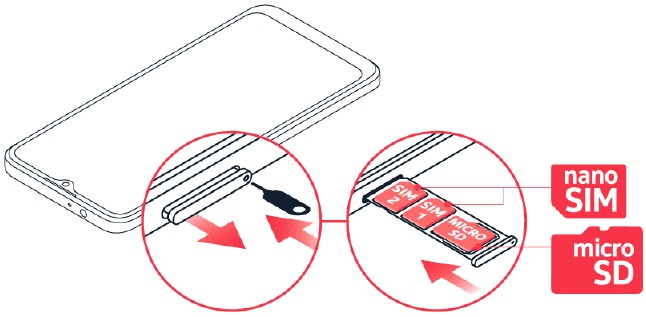
Insert the cards
- Open the SIM card tray: push the tray opener pin in the tray hole and slide the tray out.
- Put the nano-SIM in the SIM1 slot on the tray with the contact area face down.
- If you have a dual-SIM phone, put the second SIM in the SIM2 slot.
- If you have a memory card, put it in the memory card slot.
- Slide the tray back in.
Tip: To find out if your phone can use 2 SIM cards, see the label on the sales box. If there are 2 IMEI codes on the label, you have a dual-SIM phone.
Tip: Use a fast, up to 512 GB microSD memory card from a well-known manufacturer.
Do not remove the memory card when an app is using it. Doing so may damage the memory card and the device and corrupt data stored on the card.
CHARGE YOUR DEVICE
Charge the battery
- Plug a compatible charger into a wall outlet.
![]()
- Connect the cable to your phone.
Your phone supports the USB-C cable. You can also charge your phone from a computer with a USB cable, but it may take a longer time.
If the battery is completely discharged, it may take several minutes before the charging indicator is displayed.
SWITCH ON AND SET UP YOUR DEVICE
When you switch your phone on for the first time, your phone guides you to set up your network connections and phone settings.
Switch on your unit
- To switch on your phone, press and hold the power key until the phone vibrates.
- When the phone is switched on, choose your language and region.
- Follow the instructions shown on your phone.
Transfer data from your previous device
You can transfer data from an old phone to your new phone using your Google account.
To back up data on your old phone to your Google account, refer to your old phone's user guide.
Restore app settings from your previous Android device
If your previous phone was an Android, and back up to Google account is enabled on it, you can restore your app settings and Wi-Fi passwords.
- Tap
![]() >
> ![]() >
> ![]() >
> ![]() .
. - Select which data you want to restore on your new phone. The sync starts automatically once your phone is connected to the internet.
DUAL SIM SETTINGS
If you have a dual-SIM phone, you can have 2 SIMs in your phone, for example, one for your work and one for your personal use.
Choose which SIM to use
When, for example, making a call, you can choose which SIM to use by tapping the corresponding SIM 1 or SIM 2 button after you dial the number.
Your phone shows the network status for both SIMs separately. Both SIM cards are available at the same time when the device is not being used, but while one SIM card is active, when, for example, making a call, the other may be unavailable.
Manage your SIMs
Don't want work to interfere with your free time? Or do you have a cheaper data connection on one SIM? You can decide which SIM you want to use.
Tap  >
>  >
>  , and tap the SIM card.
, and tap the SIM card.
Rename a SIM card
Tap the SIM you want to rename, tap, and type in the name you want.
LOCK OR UNLOCK YOUR UNIT
Lock your phone
If you want to avoid accidentally making a call when your phone is in your pocket or bag, you can lock your keys and screen.
To lock your keys and screen, press the power key.
Unlock the keys and screen
Press the power key, and swipe up across the screen. If asked, provide additional credentials.
USE THE TOUCH SCREEN
Avoid scratching the touch screen. Never use an actual pen, pencil, or other sharp object on the touch screen.
Tap and hold to drag an item

Place your finger on the item for a couple of seconds, and slide your finger across the screen.
Swipe

Place your finger on the screen, and slide your finger in the direction you want.
Scroll through a long list or menu
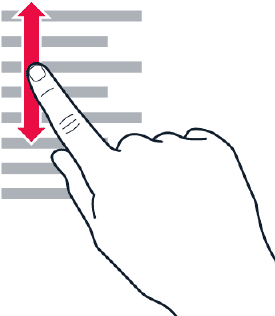
Slide your finger quickly in a flicking motion up or down the screen, and lift your finger. To stop the scrolling, tap the screen.
Zoom in or out
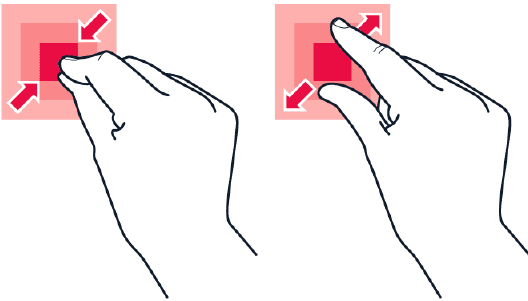
Place 2 fingers on an item, such as a map, photo, or web page, and slide your fingers apart or together.
Lock the screen orientation
The screen rotates automatically when you turn the phone 90 degrees.
To lock the screen in portrait mode, swipe down from the top of the screen, and tap  .
.
Navigate with gestures
To switch on using gesture navigation, tap  >
>  >
>  >
>  >
>  .
.
- To see all your apps, swipe up from the bottom of the screen.
- To go to the home screen, swipe up from the bottom of the screen. The app you were in stays open in the background.
- To see which apps you have open, swipe up from the bottom of the screen without releasing your finger until you see the apps, and then release your finger. To switch to another open app, tap the app. To close all the open apps, tap
![]() .
. - To go back to the previous screen you were in, swipe from the right or left edge of the screen. Your phone remembers all the apps and websites you've visited since the last time your screen was locked.
Navigate with keys
To switch on the navigation keys, tap  >
>  >
>  >
>  >
>  .
.
- To see all your apps, swipe up from the bottom of the screen.
- To go to the home screen, tap the home key. The app you were in stays open in the background.
- To see which apps you have open, tap
![]() . To switch to another open app, swipe right and tap the app. To close all the open apps, tap
. To switch to another open app, swipe right and tap the app. To close all the open apps, tap ![]() .
. - To go back to the previous screen you were in, tap
![]() . Your phone remembers all the apps and websites you've visited since the last time your screen was locked.
. Your phone remembers all the apps and websites you've visited since the last time your screen was locked.
Basics
PERSONALIZE YOUR DEVICE
Change your wallpaper
Tap  >
>  >
>  >
>  .
.
Change your phone ringtone
Tap  >
>  >
>  or
or  , and select the tone.
, and select the tone.
Change your message notification sound
Tap  >
>  >
>  >
> 
NOTIFICATIONS
Use the notification panel
When you receive new notifications, such as messages or missed calls, icons appear at the top of the screen.
To see more information about the notifications, swipe down from the top of the screen. To close the view, swipe up on the screen.
To change the notification settings of an app, tap  >
>  , tap the app name and
, tap the app name and  .
.
Use the quick setting icons

To activate features, tap the quick settings icons on the notification panel. To see more icons, drag the menu down.
To rearrange the icons, tap  , tap and hold an icon, and then drag it to another location.
, tap and hold an icon, and then drag it to another location.
CONTROL VOLUME
Change the volume
If you have trouble hearing your phone ringing in noisy environments, or calls are too loud, you can change the volume to your liking by using the volume keys on the side of your phone.
Do not connect to products that create an output signal, as this may damage the device. Do not connect any voltage source to the audio connector. If you connect an external device or headset, other than those approved for use with this device, to the audio connector, pay special attention to volume levels.
Change the volume for media and apps
Press a volume key on the side of your phone to see the volume status bar, tap  , and drag the slider on the volume bar for media and apps left or right.
, and drag the slider on the volume bar for media and apps left or right.
Set the phone to silent
To set the phone to silent, press the volume down key, tap  to set your phone to vibrate only and tap
to set your phone to vibrate only and tap  to set it to silent.
to set it to silent.
AUTOMATIC TEXT CORRECTION
Use keyboard word suggestions
Your phone suggests words as you write, to help you write quickly and more accurately. Word suggestions may not be available in all languages.
When you start writing a word, your phone suggests possible words. When the word you want is shown in the suggestion bar, select the word. To see more suggestions, tap and hold the suggestion.
Tip: If the suggested word is marked in bold, your phone automatically uses it to replace the word you wrote. If the word is wrong, tap and hold it to see a few other suggestions. If you do not want the keyboard to suggest words while typing, turn off the text corrections. Tap  >
>  >
>  >
>  . Select the keyboard you normally use. Tap
. Select the keyboard you normally use. Tap  and switch off the text correction methods you do not want to use.
and switch off the text correction methods you do not want to use.
Correct a word
If you notice that you have misspelled a word, tap it to see suggestions for correcting the word.
Switch spell checker off
Tap  >
>  >
>  >
>  >
>  , and switch
, and switch  off.
off.
GOOGLE ASSISTANT
Google Assistant is available in selected markets and languages only. Where not available, Google Assistant is replaced by Google Search. Check availability at https://support.google.com/assistant. Google Assistant can help you search information online, translate words and sentences, make notes and calendar appointments, for example. You can use Google Assistant even when your phone is locked. However, Google Assistant asks you to unlock your phone before accessing your private data.
Use the Google Assistant key
To access the Google Assistant services, use the Google Assistant key on the side of your phone:
- Press the key once to start Google Assistant.
- Press and hold the key to speak with Google Assistant. Ask your question and release the key. You see Google Assistant's answer on your phone's display.
If your country or region does not support Google Assistant, you can still use the Google Assistant key:
- Press the key once to open Google Search.
- Press and hold the key to use Google voice search. Ask your question and release the key. You see Google's answer on your phone's display.
Switch off the Google Assistant key
To switch off the Google Assistant key, tap  >
>  >
>  >
>  , and switch
, and switch  off.
off.
BATTERY LIFE
There are steps you can take to save power on your phone.
Extend battery life
To save power:
- Always charge the battery fully.
- Mute unnecessary sounds, such as touch sounds. Tap
![]() >
> ![]() >
> ![]() , and under
, and under ![]() , select which sounds to keep.
, select which sounds to keep. - Use wired headphones, rather than the loudspeaker.
- Set the phone screen to switch off after a short time. Tap
![]() >
> ![]() >
> ![]() >
> ![]() and select the time.
and select the time. - Tap
![]() >
> ![]() >
> ![]() . To adjust the brightness, drag the brightness level slider. Make sure that
. To adjust the brightness, drag the brightness level slider. Make sure that ![]() >
> ![]() is disabled.
is disabled. - Stop apps from running in the background.
- Use location services selectively: switch location services off when you don't need them. Tap
![]() >
> ![]() , and disable
, and disable ![]() .
. - Use network connections selectively: switch Bluetooth on only when needed. Use a Wi-Fi connection to connect to the internet, rather than a mobile data connection. Stop your phone scanning for available wireless networks. Tap
![]() >
> ![]() >
> ![]() , and disable
, and disable ![]() . If you're listening to music or otherwise using your phone, but don't want to make or receive calls, switch the airplane mode on. Tap
. If you're listening to music or otherwise using your phone, but don't want to make or receive calls, switch the airplane mode on. Tap ![]() >
> ![]() >
> ![]() . Airplane mode closes connections to the mobile network and switches your device's wireless features off.
. Airplane mode closes connections to the mobile network and switches your device's wireless features off.
ACCESSIBILITY
You can change various settings to make using your phone easier.
Increase or decrease the font size
Do you want to have larger fonts on your phone?
- Tap
![]() >
> ![]() .
. - Tap
![]() . To increase or decrease the font size, drag the font size level slider.
. To increase or decrease the font size, drag the font size level slider.
Increase or decrease the display size
Do you want to make the items on your screen smaller or larger?
- Tap
![]() >
> ![]() .
. - Tap
![]() and to adjust the display size, drag the display size level slider.
and to adjust the display size, drag the display size level slider.
Connect with your friends and family
CALLS
Make a call
- Tap
![]() .
. - Tap
![]() and type in a number, or tap
and type in a number, or tap ![]() and select a contact you want to call.
and select a contact you want to call. - Tap
![]() . If you have a second SIM card inserted, tap the corresponding icon to make a call from that SIM.
. If you have a second SIM card inserted, tap the corresponding icon to make a call from that SIM.
Answer a call
If your phone rings when the screen is unlocked, tap  . If your phone rings when the screen is locked, swipe up to answer.
. If your phone rings when the screen is locked, swipe up to answer.
Reject a call
If your phone rings when the screen is unlocked, tap  . If your phone rings when the screen is locked, swipe down to reject the call.
. If your phone rings when the screen is locked, swipe down to reject the call.
CONTACTS
Save a contact from call history
- Tap
![]() to see your call history.
to see your call history. - Tap the number you want to save.
- Tap
![]() . If this is a new contact, type in the contact information, and tap
. If this is a new contact, type in the contact information, and tap ![]() . If this contact is already in your contacts list, tap
. If this contact is already in your contacts list, tap ![]() , select the contact, and tap
, select the contact, and tap ![]() .
.
Add a contact
- Tap
![]() >
> ![]() .
. - Fill out the information.
- Tap
![]() .
.
SEND MESSAGES
Send a message
- Tap
![]() .
. - Tap
![]() .
. - To add a recipient, tap
![]() , type in their number, and tap
, type in their number, and tap ![]() . To add a recipient from your contacts list, start typing their name and tap the contact.
. To add a recipient from your contacts list, start typing their name and tap the contact. - To add more recipients, tap
![]() . After choosing all the recipients, tap
. After choosing all the recipients, tap ![]() .
. - Write your message in the text box.
- Tap
![]() .
.
You can send mail with your phone when you're on the go.
Add a mail account
When you use the Gmail app for the first time, you are asked to set up your email account.
- Tap
![]() .
. - You can select the address connected with your Google account or tap
![]() .
. - After adding all the accounts, tap
![]() .
.
Send mail
- Tap
![]() .
. - Tap
![]() .
. - In the
![]() box, type in an address, or tap
box, type in an address, or tap ![]() >
> ![]() .
. - Type in the message subject and the mail.
- Tap
![]() .
.
Camera
CAMERA BASICS
Take a photo
Shoot sharp and vibrant photos – capture the best moments in your photo album.
- Tap
![]() .
. - Take aim and focus.
- Tap
![]()
Take a selfie
- Tap
![]() >
> ![]() to switch to the front camera.
to switch to the front camera. - Tap
![]() .
.
Use Google Lens
With Google Lens, you can use the viewfinder of your camera to identify things, copy text, scan codes, and search for similar products, for example.
- Tap
![]() .
. - Tap
![]()
- Point the camera to the thing you want to identify, and follow the instructions on the display.
Tip: You can use Google Lens with the photos you've already taken. Tap  , tap the photo, and tap.
, tap the photo, and tap.
VIDEOS
Record a video
- Tap
![]() .
. - To switch to the video recording mode, tap
![]() .
. - Tap
![]() to start recording
to start recording - To stop recording, tap
![]() .
. - To go back to camera mode, tap
![]() .
.
YOUR PHOTOS AND VIDEOS
View photos and videos on your phone
Tap  .
.
Copy your photos and videos to your computer
Do you want to view your photos or videos on a larger screen? Move them to your computer.
You can use your computer's file manager to copy or move your photos and videos to the computer.
Connect your phone to the computer with a compatible USB cable. To set the USB connection type, open the notification panel, and tap the USB notification.
Share your photos and videos
- Tap
![]() , tap the photo you want to share and tap
, tap the photo you want to share and tap ![]() .
. - Select how you want to share the photo or video.
Internet and connections
ACTIVATE WI-FI
Using a Wi-Fi connection is generally faster and less expensive than using a mobile data connection. If both Wi-Fi and mobile data connections are available, your phone uses the WiFi connection.
Turn on Wi-Fi
- Tap
![]() >
> ![]() >
> ![]() .
. - Switch
![]() on.
on. - Select the connection you want to use.
Your Wi-Fi connection is active when  is shown on the status bar at the top of the screen.
is shown on the status bar at the top of the screen.
Use encryption to increase the security of your Wi-Fi connection. Using encryption reduces the risk of others accessing your data.
Tip: If you want to track locations when satellite signals are not available, for example when you're indoors or between tall buildings, switch Wi-Fi on to improve positioning accuracy.
BROWSE THE WEB
Search the web
- Tap
![]() .
. - Write a search word or a web address to the search field.
- Tap
![]() , or select from the proposed matches.
, or select from the proposed matches.
Tip: If your network service provider doesn't charge you a fixed fee for data transfer, to save on data costs, use a Wi-Fi network to connect to the internet.
Use your phone to connect your computer to the web
Use your mobile data connection to access the internet with your laptop or other device.
- Tap
![]() >
> ![]() >
> ![]() .
. - Switch on
![]() to share your mobile data connection over Wi-Fi,
to share your mobile data connection over Wi-Fi, ![]() to use a USB connection,
to use a USB connection, ![]() to use Bluetooth, or
to use Bluetooth, or ![]() to use a USB Ethernet cable connection.
to use a USB Ethernet cable connection.
The other device uses data from your data plan, which may result in data traffic costs. For info on availability and costs, contact your network service provider.
BLUETOOTH
You can connect wirelessly to other compatible devices, such as phones, computers, headsets, and car kits. You can also send your photos to compatible phones or to your computer.
Connect to a Bluetooth device
You can connect your phone with many useful Bluetooth devices. For example, with a wireless headset (sold separately), you can speak on the phone hands-free – you can continue what you're doing, such as working at your computer, during a call. Connecting a phone to a Bluetooth device is called pairing.
- Tap
![]() >
> ![]() >
> ![]() >
> ![]() .
. - Switch
![]() to
to ![]() .
. - Make sure the other device is switched on. You may need to start the pairing process from the other device. For details, see the user guide for the other device.
- Tap
![]() and tap the device you want to pair with from the list of discovered Bluetooth devices.
and tap the device you want to pair with from the list of discovered Bluetooth devices. - You may need to type in a passcode. For details, see the user guide for the other device.
Since devices with Bluetooth wireless technology communicate using radio waves, they do not need to be in direct line-of-sight. Bluetooth devices must, however, be within 10 meters (33 feet) of each other, although the connection may be subject to interference from obstructions such as walls or from other electronic devices.
Paired devices can connect to your phone when Bluetooth is switched on. Other devices can detect your phone only if the Bluetooth settings view is open.
Do not pair with or accept connection requests from an unknown device. This helps to protect your phone from harmful content.
Share your content using Bluetooth
If you want to share your photos or other content with a friend, send them to your friend's phone using Bluetooth.
You can use more than one Bluetooth connection at a time. For example, while using a Bluetooth headset, you can still send things to another phone.
- Tap
![]() >
> ![]() >
> ![]() >
> ![]() .
. - Make sure Bluetooth is switched on in both phones and the phones are visible to each other.
- Go to the content you want to send, and tap
![]() >
> ![]() .
. - On the list of found Bluetooth devices, tap your friend's phone.
- If the other phone needs a passcode, type in or accept the passcode, and tap
![]() .
.
The passcode is only used when you connect to something for the first time.
Remove a pairing
If you no longer have the device with which you paired your phone, you can remove the pairing.
- Tap
![]() >
> ![]() >
> ![]() .
. - Tap
![]() next to a device name.
next to a device name. - Tap
![]() .
.
VPN
You may need a virtual private network (VPN) connection to access your company resources, such as intranet or corporate mail, or you may use a VPN service for personal purposes.
Contact your company IT administrator for details of your VPN configuration, or check your VPN service's website for additional info.
Use a secure VPN connection
- Tap
![]() >
> ![]() >
> ![]() >
> ![]()
- To add a VPN profile, tap.
- Type in the profile info as instructed by your company IT administrator or VPN service.
Edit a VPN profile
- Tap
![]() next to a profile name.
next to a profile name. - Change the info as required.
Delete a VPN profile
- Tap
![]() next to a profile name.
next to a profile name. - Tap
![]() .
.
Organize your day
DATE AND TIME
Set date and time
Tap  >
>  >
>  .
.
Update the time and date automatically
You can set your phone to update the time, date, and time zone automatically. Automatic update is a network service and may not be available depending on your region or network service provider.
- Tap
![]() >
> ![]() >
> ![]() .
. - Switch
![]() on.
on. - Switch
![]() on.
on.
Change the clock to the 24-hour format
Tap  >
>  >
>  , and switch
, and switch  on.
on.
ALARM CLOCK
Set an alarm
- Tap
![]() >
> ![]() .
. - To add an alarm, tap
![]() .
. - Select the hour and the minutes, and tap
![]() .
. - To set the alarm to repeat on specific days, tap the corresponding weekdays.
Switch an alarm off
When the alarm sounds, swipe the alarm right.
CALENDAR
Manage calendars
Tap  >
>  , and select what type of calendar you want to see.
, and select what type of calendar you want to see.
Calendars are added automatically when you add an account to your phone. To add a new account with a calendar, go to the apps menu and tap  >
>  >
>  .
.
Add an event
- In
![]() , tap + and select the entry type.
, tap + and select the entry type. - Type in the details you want, and set the time.
- To make an event repeat on certain days, tap
![]() , and select how often the event should repeat.
, and select how often the event should repeat. - To set a reminder, tap
![]() and set the time.
and set the time. - Tap
![]() .
.
Tip: To edit an event, tap the event and  , and edit the details.
, and edit the details.
Delete an appointment
- Tap the event.
- Tap
![]() >
> ![]() .
.
Maps
FIND PLACES AND GET DIRECTIONS
FIND A SPOT
 helps you find specific locations and businesses.
helps you find specific locations and businesses.
- Tap
![]() .
. - Write search words, such as a street address or place name, in the search bar.
- Select an item from the list of proposed matches as you write, or tap
![]() to search.
to search.
The location is shown on the map. If no search results are found, make sure the spelling of your search words is correct.
SEE YOUR CURRENT LOCATION
Tap  >
>  .
.
GET DIRECTIONS TO A PLACE
- Tap
![]() and enter your destination in the search bar.
and enter your destination in the search bar. - Tap
![]() . The highlighted icon shows the mode of transportation, for example
. The highlighted icon shows the mode of transportation, for example ![]() . To change the mode, select the new mode under the search bar.
. To change the mode, select the new mode under the search bar. - If you don't want the starting point to be your current location, tap
![]() , and search for a new starting point.
, and search for a new starting point. - Tap
![]() to start the navigation.
to start the navigation.
The route is shown on the map, along with an estimate of how long it takes to get there. To see detailed directions, tap  .
.
Apps, updates and backups
GET APPS FROM GOOGLE PLAY
You need to have a Google account added to your phone to use Google Play services. Charges may apply to some of the content available in Google Play. To add a payment method, tap  , tap your Google logo on the search field, and then tap
, tap your Google logo on the search field, and then tap  . Always be sure to have a permission from the payment method owner when buying content from Google Play.
. Always be sure to have a permission from the payment method owner when buying content from Google Play.
Download apps
- Tap
![]() .
. - Tap the search bar to look for apps, or select apps from your recommendations.
- In the app description, tap
![]() to download and install the app.
to download and install the app.
To see your apps, go to the home screen and swipe up from the bottom of the screen.
FREE UP SPACE ON YOUR DEVICE
If your phone memory is getting full, move files to a memory card or delete unnecessary files.
Transfer files to a memory card
To move photos from your phone memory to a memory card, tap  >
>  . Press and hold the photo you want to move, and tap
. Press and hold the photo you want to move, and tap  >
>  >
>  .
.
To move documents and files, tap  >
>  . Tap
. Tap  next to the file name, and tap
next to the file name, and tap  .
.
UPDATE YOUR PRODUCT SOFTWARE
Stay in step with the beat – update your phone software and apps wirelessly to get new and enhanced features for your phone. Updating the software may also improve your phone performance.
Install available updates
Tap  >
>  >
>  >
>  >
>  to check if updates are available.
to check if updates are available.
When your phone notifies you that an update is available, just follow the instructions shown on your phone. If your phone is low on memory, you may need to move your photos and other stuff to the memory card.
If you install a software update, you cannot use the device, even to make emergency calls, until the installation is completed and the device is restarted.
Before starting the update, connect a charger or make sure the device battery has enough power, and connect to Wi-Fi, as the update packages may use up a lot of mobile data.
BACK UP YOUR DATA
To ensure your data is safe, use the backup feature in your phone. Your device data (such as Wi-Fi passwords and call history) and app data (such as settings and files stored by apps) will be backed up remotely.
Switch on automatic backup
Tap  >
>  >
>  , and switch back up on.
, and switch back up on.
RESTORE ORIGINAL SETTINGS AND REMOVE PRIVATE CONTENT FROM YOUR UNIT
Accidents can happen – if your phone is not working properly, you can restore its settings. Or, if you buy a new phone, or otherwise want to dispose of or recycle your phone, here's how you can remove your personal info and content. Note that it is your responsibility to remove all private content.
Reset your phone
- Tap
![]() >
> ![]() >
> ![]() >
> ![]() >
> ![]()
- Follow the instructions shown on your phone.
Protect your product
PROTECT YOUR UNIT WITH A SCREEN LOCK
You can set your phone to require authentication when unlocking the screen.
Set a screen lock
- Tap
![]() >
> ![]() >
> ![]() .
. - Choose the type of lock and follow the instructions on your phone.
PROTECT YOUR UNIT WITH YOUR FINGERPRINT
Add a fingerprint
- Tap
![]() >
> ![]() >
> ![]() .
. - Select what backup unlocking method you want to use for the lock screen and follow the instructions shown on your phone.
Unlock your phone with your finger
Place your registered finger on the power key.
If there is a fingerprint sensor error, and you cannot use alternative sign-in methods to recover or reset the phone in any way, your phone will require service by authorized personnel. Additional charges may apply, and all the personal data on your phone may be deleted. For more info, contact the nearest care point for your phone, or your phone dealer.
PROTECT YOUR UNIT WITH YOUR FACE
Set up face authentication
- Tap
![]() >
> ![]() >
> ![]() .
. - Select what backup unlocking method you want to use for the lock screen and follow the instructions shown on your phone.

Keep your eyes open and make sure your face is fully visible and not covered by any object, such as a hat or sunglasses.

Face unlock may not work properly in backlight or too dark or bright environment.
Unlock your phone with your face
To unlock your phone, just turn your screen on and look at the camera.
If there is a facial recognition error, and you cannot use alternative sign-in methods to recover or reset the phone in any way, your phone will require service. Additional charges may apply, and all the personal data on your phone may be deleted. For more info, contact the nearest authorized service facility for your phone, or your phone dealer.
CHANGE YOUR SIM PIN CODE
If your SIM card came with a pre-set PIN code, you can change it to something more secure.
Not all network service providers support this.
Select your SIM PIN code
You can choose which digits to use for the SIM PIN. The SIM PIN code can be 4-8 digits.
- Tap
![]() >
> ![]() >
> ![]() >
> ![]() .
. - Under the selected SIM card, tap
![]() .
.
ACCESS CODES
Learn what the different codes on your phone are for.
PIN or PIN2 code
PIN or PIN2 codes have 4-8 digits.
These codes protect your SIM card against unauthorized use or are required to access some features. You can set your phone to ask for the PIN code when you switch it on.
If you forget the codes or they aren't supplied with your card, contact your network service provider.
If you type in the code incorrectly 3 times in a row, you need to unblock the code with the PUK or PUK2 code.
PUK or PUK2 codes
PUK or PUK2 codes are required to unblock a PIN or PIN2 code.
If the codes are not supplied with your SIM card, contact your network service provider.
Lock code
Lock code is also known as security code or password.
The lock code helps you protect your phone against unauthorized use. You can set your phone to ask for the lock code that you define. Keep the code secret and in a safe place, separate from your phone.
If you forget the code and your phone is locked, your phone will require service. Additional charges may apply, and all the personal data on your phone may be deleted. For more info, contact the nearest authorized service facility for your phone, or your phone dealer.
IMEI code
The IMEI code is used to identify phones in the network. You may also need to give the number to your authorized service facility or phone dealer. To view your IMEI code:
- dial *#06#
- check the original sales box
If the IMEI code is printed on your phone, you may find it, for example, on the SIM tray or under the back cover, if your phone has a removable cover.
Locate or lock your device
If you lose your phone, you may be able to find, lock, or erase it remotely if you have signed in to a Google Account. Find My Device is on by default for phones associated with a Google Account.
To use Find My Device, your lost phone must be:
- Turned on
- Signed in to a Google Account
- Connected to mobile data or Wi-Fi
- Visible on Google Play
- Location turned on
- Find My Device turned on
When Find My Device connects with your phone, you see the phone's location, and the phone gets a notification.
- Open android.com/find on a computer, tablet or phone connected to the internet and sign in to your Google Account.
- If you have more than one phone, click the lost phone at the top of the screen.
- On the map, see about where the phone is. The location is approximate and may not be accurate.
If your device can't be found, Find My Device will show its last known location, if available. To lock or erase your phone, follow the instructions on the web site.
Product and safety information
FOR YOUR SAFETY
Read these simple guidelines. Not following them may be dangerous or against local laws and regulations. For further info, read the complete user guide.
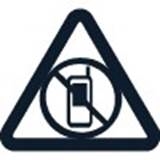
SWITCH OFF IN RESTRICTED AREAS
Switch the device off when mobile device use is not allowed or when it may cause interference or danger, for example, in aircraft, in hospitals or near medical equipment, fuel, chemicals, or blasting areas. Obey all instructions in restricted areas.

ROAD SAFETY COMES FIRST
Obey all local laws. Always keep your hands free to operate the vehicle while driving. Your first consideration while driving should be road safety.

INTERFERENCE
All wireless devices may be susceptible to interference, which could affect performance.

AUTHORIZED SERVICE
Only authorized personnel may install or repair this product.

BATTERIES, CHARGERS, AND OTHER ACCESSORIES
Use only batteries, chargers, and other accessories approved by HMD Global Oy for use with this device. Do not connect incompatible products.

KEEP YOUR DEVICE DRY
If your device is water-resistant, see its IP rating in the device's technical specifications for more detailed guidance.

GLASS PARTS
The device and/or its screen is made of glass. This glass can break if the device is dropped on a hard surface or receives a substantial impact. If the glass breaks, do not touch the glass parts of the device or attempt to remove the broken glass from the device. Stop using the device until the glass is replaced by authorized service personnel.
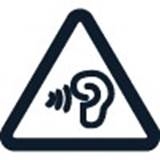
PROTECT YOUR HEARING
To prevent possible hearing damage, do not listen at high volume levels for long periods. Exercise caution when holding your device near your ear while the loudspeaker is in use.

SAR
This device meets RF exposure guidelines when used either in the normal use position against the ear or when positioned at least 1.5 centimetres (5/8 inch) away from the body.
NETWORK SERVICES AND COSTS
Using some features and services, or downloading content, including free items, require a network connection. This may cause the transfer of large amounts of data, which may result in data costs. You may also need to subscribe to some features.
4G/LTE might not be supported by your network service provider or by the service provider you are using when traveling. In these cases, you may not be able to make or receive calls, send or receive messages or use mobile data connections. To make sure your device works seamlessly when full 4G/LTE service is not available, it is recommended that you change the highest connection speed from 4G to 3G. To do this, on the home screen, tap  >
>  >
>  , and switch
, and switch  to
to  . For more info, contact your network service provider.
. For more info, contact your network service provider.

EMERGENCY CALLS
Connections in all conditions cannot be guaranteed. Never rely solely on any wireless phone for essential communications like medical emergencies.
Before making the call:
- Switch the phone on.
- If the phone screen and keys are locked, unlock them.
- Move to a place with adequate signal strength.
On the home screen, tap  .
.
- Type in the official emergency number for your present location. Emergency call numbers vary by location.
- Tap
![]() .
. - Give the necessary info as accurately as possible. Do not end the call until given permission to do so.
You may also need to do the following:
- Put a SIM card in the phone. If you don't have a SIM card, on the lock screen, tap
![]() .
. - If your phone asks for a PIN code, tap
![]() .
. - Switch the call restrictions off in your phone, such as call barring, fixed dialling, or closed user group.
- If the mobile network is not available, you may also try making an internet call, if you can access the internet.
TAKE CARE OF YOUR DEVICE
Handle your device, battery, charger and accessories with care. The following suggestions help you keep your device operational.
- Keep the device dry. Precipitation, humidity, and all types of liquids or moisture can contain minerals that corrode electronic circuits.
- Do not use or store the device in dusty or dirty areas.
- Do not store the device in high temperatures. High temperatures may damage the device or battery.
- Do not store the device in cold temperatures. When the device warms to its normal temperature, moisture can form inside the device and damage it.
- Do not open the device other than as instructed in the user guide.
- Unauthorized modifications may damage the device and violate regulations governing radio devices.
- Do not drop, knock, or shake the device or the battery. Rough handling can break it.
- Only use a soft, clean, dry cloth to clean the surface of the device.
- Do not paint the device. Paint can prevent proper operation.
- Keep the device away from magnets or magnetic fields.
- To keep your important data safe, store it in at least two separate places, such as your device, memory card, or computer, or write down important info.
During extended operation, the device may feel warm. In most cases, this is normal. To avoid getting too warm, the device may automatically slow down, dim display during a video call, close apps, switch off charging, and if necessary, switch itself off. If the device is not working properly, take it to the nearest authorized service facility.
BATTERY AND CHARGER INFORMATION
Battery and charger info
To check if your phone has a removable or non-removable battery, see the printed guide.
Devices with a removable battery Use your device only with an original rechargeable battery. The battery can be charged and discharged hundreds of times, but it will eventually wear out. When the talk and standby times are noticeably shorter than normal, replace the battery.
Devices with a non-removable battery Do not attempt to remove the battery, as you may damage the device. The battery can be charged and discharged hundreds of times, but it will eventually wear out. When the talk and standby times are noticeably shorter than normal, to replace the battery, take the device to the nearest authorized service facility.
Charge your device with a compatible charger. Charger plug type may vary. Charging time can vary depending on device capability.
Battery and charger safety info
Once charging of your device is complete, unplug the charger from the device and electrical outlet. Please note that continuous charging should not exceed 12 hours. If left unused, a fully charged battery will lose its charge over time.
Extreme temperatures reduce the capacity and lifetime of the battery. Always keep the battery between 15°C and 25°C (59°F and 77°F) for optimal performance. A device with a hot or cold battery may not work temporarily. Note that the battery may drain quickly in cold temperatures and lose enough power to switch off the phone within minutes. When you are outdoors in cold temperatures, keep your phone warm.
Obey local regulations. Recycle when possible. Do not dispose as household waste.
Do not expose the battery to extremely low air pressure or leave it to extremely high temperature, for example dispose it in a fire, as that may cause the battery to explode or leak flammable liquid or gas.
Do not dismantle, cut, crush, bend, puncture, or otherwise damage the battery in any way. If a battery leaks, do not let liquid touch skin or eyes. If this happens, immediately flush the affected areas with water, or seek medical help. Do not modify, attempt to insert foreign objects into the battery, or immerse or expose it to water or other liquids. Batteries may explode if damaged.

To unplug a charger or an accessory, hold and pull the plug, not the cord.
Additionally, the following applies if your device has a removable battery:
- Always switch the device off and unplug the charger before removing the battery.
- Accidental short-circuiting can happen when a metallic object touches the metal strips on the battery. This may damage the battery or the other object.
SMALL CHILDREN
Your device and its accessories are not toys. They may contain small parts. Keep them out of the reach of small children.
MEDICAL DEVICES
Operation of radio transmitting equipment, including wireless phones, may interfere with inadequately shielded medical devices' function. Consult a physician or the medical device's manufacturer to determine if it is adequately shielded from external radio energy.
IMPLANTED MEDICAL DEVICES
To avoid potential interference, manufacturers of implanted medical devices (such as cardiac pacemakers, insulin pumps, and neurostimulators) recommend a minimum separation of 15.3 centimeters (6 inches) between a wireless device and the medical device. Persons who have such devices should:
- Always keep the wireless device more than 15.3 centimeters (6 inches) from the medical device.
- Not carry the wireless device in a breast pocket.
- Hold the wireless device to the ear opposite the medical device.
- Switch the wireless device off if there is any reason to suspect that interference is taking place.
- Follow the manufacturer directions for the implanted medical device.
If you have any questions about using your wireless device with an implanted medical device, consult your health care provider.
HEARING
When you use the headset, your ability to hear outside sounds may be affected. Do not use the headset where it can endanger your safety.
Some wireless devices may interfere with some hearing aids.
PROTECT YOUR DEVICE FROM HARMFUL CONTENT
Your device may be exposed to viruses and other harmful content. Take the following precautions:
- Be cautious when opening messages. They may contain malicious software or otherwise be harmful to your device or computer.
- Be cautious when accepting connectivity requests, browsing the internet, or downloading content. Do not accept Bluetooth connections from sources you do not trust.
- Only install and use services and software from sources that you trust and that offer adequate security and protection.
- Install antivirus and other security software on your device and any connected computer. Only use one antivirus app at a time. Using more may affect performance and operation of the device and/or computer.
- If you access preinstalled bookmarks and links to third party internet sites, take the appropriate precautions. HMD Global does not endorse or assume liability for such sites.
VEHICLES
Radio signals may affect improperly installed or inadequately shielded electronic systems in vehicles. For more info, check with the manufacturer of your vehicle or its equipment. Only authorized personnel should install the device in a vehicle. Faulty installation may be dangerous and invalidate your warranty. Check regularly that all wireless device equipment in your vehicle is mounted and operating properly. Do not store or carry flammable or explosive materials in the same compartment as the device, its parts, or accessories. Do not place your device or accessories in the air bag deployment area.
POTENTIALLY EXPLOSIVE ENVIRONMENTS

Documents / Resources
References
Download manual
Here you can download full pdf version of manual, it may contain additional safety instructions, warranty information, FCC rules, etc.
Advertisement

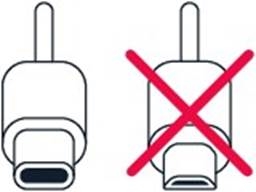
 >
>  >
>  >
>  .
. .
. . To switch to another open app, swipe right and tap the app. To close all the open apps, tap
. To switch to another open app, swipe right and tap the app. To close all the open apps, tap  . Your phone remembers all the apps and websites you've visited since the last time your screen was locked.
. Your phone remembers all the apps and websites you've visited since the last time your screen was locked. >
>  , and under
, and under  , select which sounds to keep.
, select which sounds to keep.  >
>  >
>  and select the time.
and select the time.  . To adjust the brightness, drag the brightness level slider. Make sure that
. To adjust the brightness, drag the brightness level slider. Make sure that  is disabled.
is disabled.  , and disable
, and disable  .
.  >
>  , and disable
, and disable  . If you're listening to music or otherwise using your phone, but don't want to make or receive calls, switch the airplane mode on. Tap
. If you're listening to music or otherwise using your phone, but don't want to make or receive calls, switch the airplane mode on. Tap  . Airplane mode closes connections to the mobile network and switches your device's wireless features off.
. Airplane mode closes connections to the mobile network and switches your device's wireless features off.  >
>  .
. . To increase or decrease the font size, drag the font size level slider.
. To increase or decrease the font size, drag the font size level slider. and to adjust the display size, drag the display size level slider.
and to adjust the display size, drag the display size level slider. .
. and type in a number, or tap
and type in a number, or tap  and select a contact you want to call.
and select a contact you want to call. to see your call history.
to see your call history. . If this is a new contact, type in the contact information, and tap
. If this is a new contact, type in the contact information, and tap  . If this contact is already in your contacts list, tap
. If this contact is already in your contacts list, tap  , select the contact, and tap
, select the contact, and tap  >
>  .
. .
. .
. .
. , type in their number, and tap
, type in their number, and tap  . To add a recipient from your contacts list, start typing their name and tap the contact.
. To add a recipient from your contacts list, start typing their name and tap the contact. . After choosing all the recipients, tap
. After choosing all the recipients, tap  .
. .
. .
. .
. .
. .
.  box, type in an address, or tap
box, type in an address, or tap  >
>  .
.  .
.  .
.
 to switch to the front camera.
to switch to the front camera.
 .
.  to start recording
to start recording .
.  .
. .
. >
>  >
>  .
. on.
on. .
. , or select from the proposed matches.
, or select from the proposed matches. >
>  >
>  .
. to share your mobile data connection over Wi-Fi,
to share your mobile data connection over Wi-Fi,  to use a USB connection,
to use a USB connection,  to use Bluetooth, or
to use Bluetooth, or  to use a USB Ethernet cable connection.
to use a USB Ethernet cable connection. >
>  >
>  >
>  .
.  to
to  .
.  and tap the device you want to pair with from the list of discovered Bluetooth devices.
and tap the device you want to pair with from the list of discovered Bluetooth devices.  >
>  .
.  .
. next to a device name.
next to a device name. .
. >
>  >
>  >
> 
 on.
on. on.
on. >
>  .
. .
. .
. , and select how often the event should repeat.
, and select how often the event should repeat.  and set the time.
and set the time.  .
.  >
>  .
. to search.
to search. . The highlighted icon shows the mode of transportation, for example
. The highlighted icon shows the mode of transportation, for example  . To change the mode, select the new mode under the search bar.
. To change the mode, select the new mode under the search bar. , and search for a new starting point.
, and search for a new starting point. to start the navigation.
to start the navigation. to download and install the app.
to download and install the app.
 >
> 
 >
>  >
>  .
. .
. .
. >
>  .
. .
. .
.



















Need help?
Do you have a question about the G21 and is the answer not in the manual?
Questions and answers